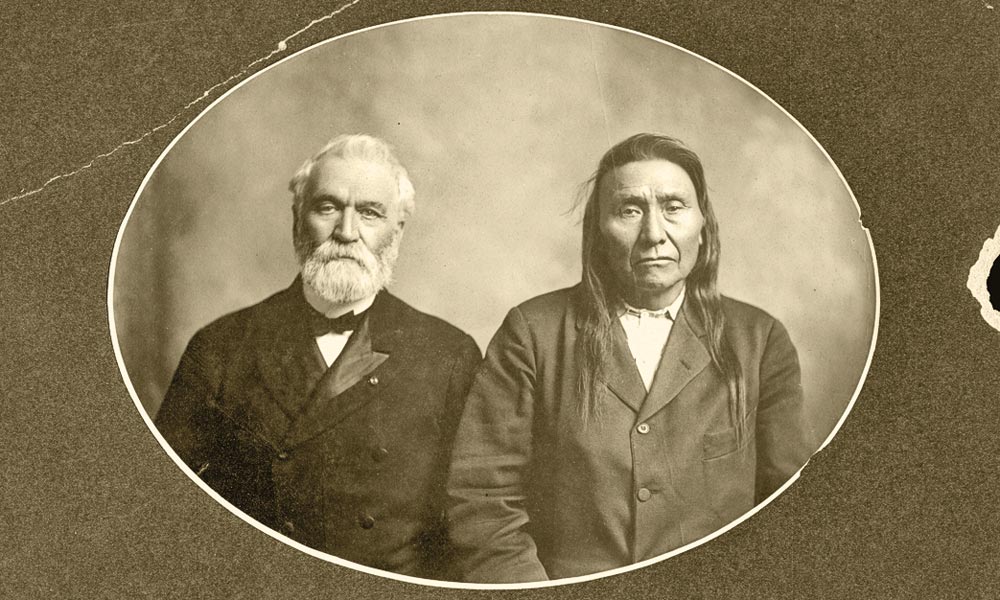
Few conflicts between the United States government and tribes of the Western United States in the 19th century have created as much literature as the Nez Perce War of 1877. The latest epic retelling of the tragic war, and the roles of famous participants’ lives before and after Chief Joseph’s famous flight for freedom—and immortal surrender speech—is brilliantly synthesized in Daniel J. Sharfstein’s Thunder in the Mountains: Chief Joseph, Oliver Otis Howard and the Nez Perce War (WW Norton, $29.95).
A Vanderbilt University professor of law and history, Sharfstein has written a dual biography of Joseph and Gen. Oliver O. Howard that brilliantly integrates the supporting cast of men and women who influenced both leaders before and after the Nez Perce fought the U.S. Army circuitously across the Northwest. As Sharfstein, a 2013 Guggenheim Fellow, notes, “Thunder in the Mountains attempts to tell Joseph and Howard’s story—the story of their world—through the eyes of the people living in it.”

The strength of Sharfstein’s expansion of the story beyond the two primary historical figures provides greater knowledge of the roles of numerous Nez Perce and American leaders—Tuekakas (Joseph’s father), Ollokot (Joseph’s brother), Chief Looking Glass, Yellow Wolf (Joseph’s nephew), Willie Andrews (aka Nicky Mowitz, Joseph’s adopted son) and Peopeo Tholekt (a key ally of Joseph’s before and after the war). Sharfstein also recounts the importance of Gen. Nelson A. Miles in Howard’s life before, during and after the Civil War; Indian advocate Alfred B. Meacham; Howard’s aide, Charles Erskine Scott Wood, a future friend and supporter of Joseph; Yakima rancher Lucullus McWhorter’s oral history interviews of numerous Nez Perce War veterans; and the role and influence of Lizzie Howard, and their family, on the pious Gen. Howard.
In the Acknowledgments, Sharfstein points out that “people have been writing books about the Nez Perce War almost from the moment it ended in 1877.” While humbly acknowledging the many chroniclers, oral historians, authors, historians and voices who have created the historiography of the Nez Perce War—and the primary and secondary participants in the conflict between the federal government, settlers and Joseph’s bands—the author’s six years of research, travel and writing has resulted in Thunder in the Mountains being the most comprehensive synthesis to present, as well as the most valuable resource for researchers, thanks to Sharfstein’s comprehensive, historiographical acknowledgments and detailed endnotes. The author’s passion for his subject matter did not end after visiting numerous archives, but extended into the field, where he rode horseback into Yellowstone along the trail of the Nez Perce, traveled by car and on foot into the heart of the Nez Perce lands and the sacred battlesites on the Nez Perce Trail in Oregon, Washington, Idaho, Wyoming and Montana.

Beyond Sharfstein’s important retelling of the historical record, and his expert synthesis of so many voices and interpretations of the Nez Perce War’s participants since 1877, are his conclusions that the dual story of Chief Joseph and Gen. Oliver O. Howard is a timeless parable of two pious men who served, led and fought with honor and dignity for their nation’s causes. In 2017, Sharfstein’s Thunder in the Mountains will resonate loudly and remind its readers that basic human rights in a democracy should never be taken for granted.
—Stuart Rosebrook





